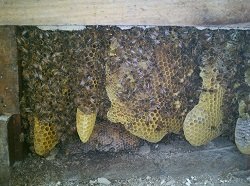How to Remove Bees Using
Trap Out
How to remove bees when you can’t get to the comb can be frustrating. But the trap out method will do the job. When explaining to potential customers the general process of removing bees, many become perplexed when they realize that the location of the honeybee hive makes it impossible to cut out the comb. But, they are very relieved when they hear how to remove bees using a trap out. Most of these customers are ready to give up and just spray the honey bee hive entrance and hope for the best.
But, here is the method that will remove bees even in the hardest [or impossible] to reach locations:
Trap out bee hive removals – Require time and lots of miles for site visits.
Trap Outs take 6 – 8 weeks depending on the size of the colony and the amount of resources and brood in the hive.
Steps to Honeybee Hive Trap Out Removals
- Observe where the entrance of the beehive location is:
- Bee activity around the entrance should be very regular.Hot days may produce “bearding” which happens when bees gather outside the entrance to cool off.
- Make sure that you find all the entrances. Some hives have multiple entrances in the building or tree.
- Setup necessary equipment for the trap out process
- Bee veil, gloves, and bee smoker
- Super or nuc with frames of foundation or drawn comb [better] and at least one frame from another hive with eggs
- #8 hardware cloth formed into a trap out cone that ends with an opening just big enough for 2 bees
- Tools and materials necessary to build platform for new hive super to rest on at trap out cone.
- Ladders, scaffold, worktable, as necessary
- Close off all entrances to the hive except the one on which the trap out cone is to be placed.
- Setup platform or resting place for the new honeybee hive body [bottom board, super with frames, inner cover and outer cover] where the bees can walk directly from the base of the trap out cone to the entrance to the hive body on the bottom board.
- Install trap out cone over remaining entrance to the hive.
- Be sure the cone is sealed all the way around at the base so that no bees can enter back into the hive around the cone. [If this is not ensured, with this and all entrances the trap out will fail.]
- Watch as bees come back
to the trapped out entrance and begin to pile up at the base of the
cone.
In awhile [could be a soon as 30 minutes, but may take up to an hour or two] you should see the trapped out bees begin to walk into the new hive. - The bees have been attracted by the eggs in the new hive and will begin to nurse them.
- Check back in a week to
look for supercedure [queen] cells in the new hive, and also make sure
the bees have not found another entrance to the old hive. Check traffic
through the trap out cone. [If they have, this will defeat the whole bee hive removal]
- Third trip [End of second week] check for hatched queen cells. Check traffic through the trap out cone.
- Fourth trip [End of third
week] check for eggs in the new hive. If so, your new queen is back from
her mating flight and at her business. Your new hive will begin growing
in population.
Check to see if bees are still coming out of the trap out cone. - At some point in the
process the queen in the old hive will notice her workers are
disappearing and the resources are dwindling.
She will usually take the rest of the bees with her and abscond from the hive. - Fifth Trip [End of fourth
week] new queen should definitely have new eggs present.
Continue to check traffic through the cone.
Traffic may be down to a single bee every few minutes.
The cone must be left in place until all traffic from the cone has stopped for at least two weeks.
This will ensure all larvae have become adult workers and left the hive after the queen has left the old hive. - When traffic out of the old hive through the cone is completely ended:
- You can remove the cone
- Bees in the new hive will rob all the left over honey and pollen from the old hive comb, leaving it clean.
- Once activity from the new hive to the old hive has ceased [can take a couple of weeks], the old comb is empty and clean.
- Seal up the entrance. This should prevent any new honey bee colonies from moving back in.
- The new hive can be moved to the beekeeper’s apiary, and all the setup materials for the trap out removed.
List your favorite or find a new one to try!


If you see bees going in and out of a structure, you may be in for a surprise as to what is behind the wall.